CTIA Wireless 2003
Mar 16, 2003, 7:00 PM by Rich Brome
In-depth coverage of the wireless event of the year. News, photos, and daily reports - live from the show floor in New Orleans. The most extensive show coverage on the web.
Intro
CTIA Wireless 2003 took place March 17-19 in New Orleans, and Phone Scoop was there to bring you the inside scoop from North America's largest wireless event. I met with all the major companies, collected all kinds of great information, and took plenty of pictures.
The coverage is broken down into several sections:
- The Daily Reports consist of photos and loads of info from my meetings
with all of the major companies at the show:
- Preview: Photos and info from the MobileFocus event the night before the show. Companies covered include Kyocera, Sprint, Samsung, and Hitachi.
- Day 1: Info from the Sprint PCS press conference, Verizon Wireless press conference, and meetings with Motorola, Audiovox, Siemens, Panasonic, and TTPCom. Also, some hands-on time with the Samsung Matrix Phone.
- Day 2: Info from LG, Nokia, Nixxo, Telson, Sony Ericsson, NEC, and Danger.
- Day 3: More from Nokia, meeting with Kyocera, Fashion Show photos, Mobile Tornado Push-To-Talk, and Bill Gates' MMDC 2003 keynote.
- Finally, a separate wrap-up report, State of the Industry, contains a concise analysis of the major news from the show, with background to put it all in perspective.
Preview
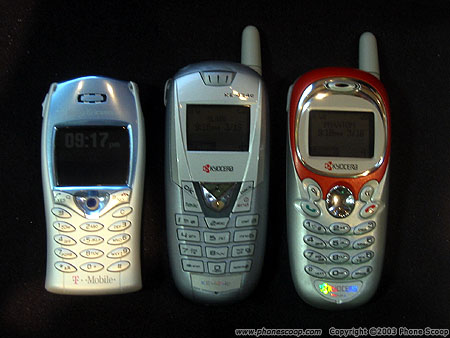
The new Kyocera Blade (middle) and Phantom (right), next to a T68i. The Blade and Phantom are part of a mix-and-match platform. Carriers can choose from three exteriors, color or grayscale displays, and modes and frequencies (tri-mode, single-band, etc.) The Phantom design supports user-changeable color bezels around the display. The other two designs have an integrated flashlight.
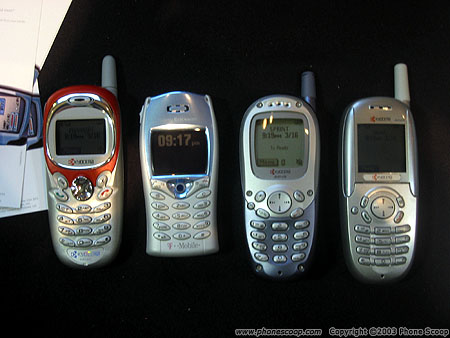
The Phantom, a T68i, a 3245, and a 3225c (3225 with color display).

The 3245 features a rugged-looking design, and carriers can choose a battery cover with an integrated carabiner (sport clip).
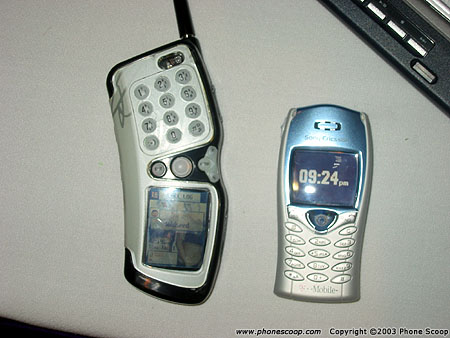
The new Wildseed phone. Kyocera will be manufacturing the CDMA version, which will be marketed as the Kyocera Kurv. Wildseed also announced that Curitel will be manufacturing a GSM version. The phone struck me as rather thick and bulky.
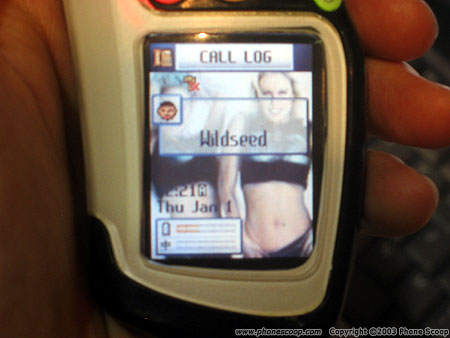
The hallmark feature of the Wildseed design is the SmartSkins - faceplates that include and integrated smart chip which adds content to the phone (ringtones and graphics). Announced at CTIA was a Smart Skin featuring the Coors Light twins, shown here.
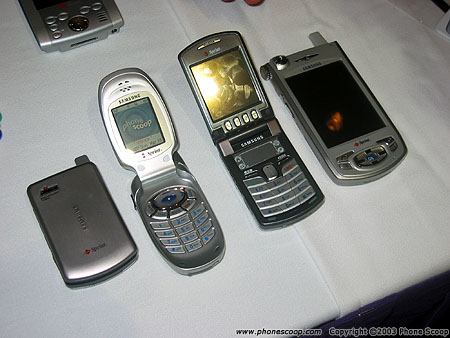
A Samsung SPH-i500 (closed), and A500, an i500 open, and an SPH-700.
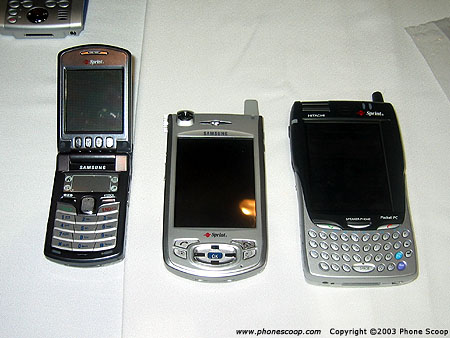
A Samsung SPH-500, SPH-i700, and a Hitachi G1000. The i700 and G1000 are both Pocket PC Phone Edition devices, and Sprint has committed to bring both to market in the 2nd quarter,
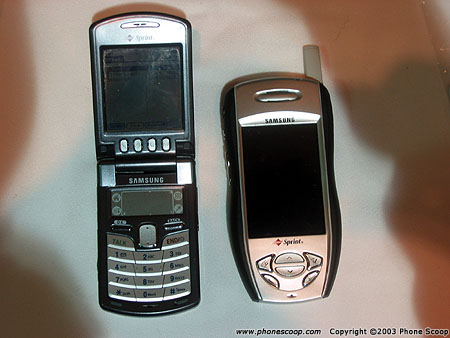
The Samsung SPH-i500 next to an i330. The i500 is remarkably small.
Day 1
Page 1
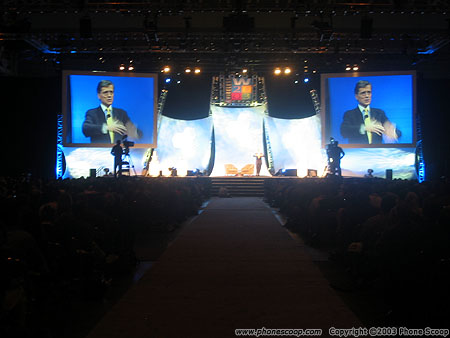
The first day keynote event. Tom Wheeler - President & CEO of CTIA, led discussions with a number of industry leaders. Texas intruments unveiled a new wireless PDA reference design with every major type of wireless - 802.11, GPRS, and Bluetooth. During the Intel demo, Neverwinter Nights was demo'd on several devices, including a Pocket PC and a Microsoft Smartphone. Both the Samsung i600 and the Mitac Smartphone made appearances. On a less serious note, it was clear that Tom Wheeler really likes Neverwinter Nights!

Sprint announced two new camera phones: the Sanyo 8100 (middle) and Samsung A600 (right). Both will be available during the 2nd quarter.
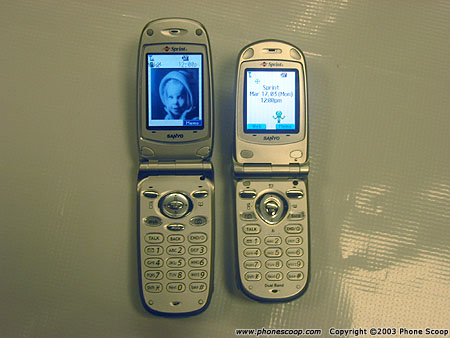
The Sanyo 8100 is smaller than the 5300.

The 8100 can send 10-second voice clips along with photos. This is designed to make it quicker and easier to take a photo and explain it - voice is much faster than text, no matter how fast you are with T9. Improvements have also been made to the UI, to make it faster and easier to take and send photos.

The new Samsung SPH-A600 features Samsung's innovative twisting display. It also has a swivel camera, with a fixed flash on the back.

The A600 is larger than the A500, but only by a small amount. The shape makes it look larger.

The twisting display in action. The display feels solid, and the twisting action has a good feel to it.
After the Sprint press conference, I went to a Verizon press conference where they announced the commercial launch of 1xEV-DO in Washington and San Diego.
The company recently concluded technology trials in those cities using trial networks. The tests were very successful, and if the same success is found with the commercial trial, Verizon Wireless executive vice president and chief technical officer Dick Lynch seems anxious to take the network nationwide. Verizon's acquisition of Northcoast gives them the spectrum they would need to do this.
The emphasis was on the corporate market, but the service will be available to consumers. I asked Mr. Lynch if he had plans to roll out 1xEV-DO handsets as well, and he indicated that he did. This is pretty exciting, because some of the most advanced phones in the world are the latest 1xEV-DO phones recently introduced in Korea.

"Motoheaven": the Motorola Phone Case.

Although there will be no official announcement for it, Motorola has now made the v60x (left) public. It is simply the 1xRTT upgrade to the popular CDMA v60i. Next is the new E310, a gaming-oriented CDMA clamshell. Next to it is the new V810. Last on the right is the V600 GSM phone. (All the units shown are non-working mockups.)
Page 2
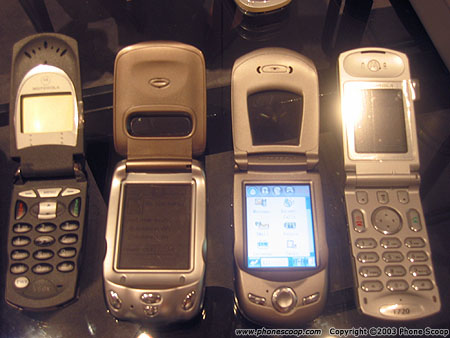
The A388c and A760 smartphones, next to the v60x and T720 for size comparison.
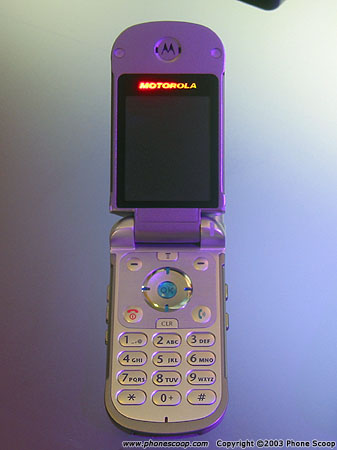
The new CDMA V810. This CDMA clamshell packs a 262,000-color display and camera with flash into an amazingly tiny, sleek design.
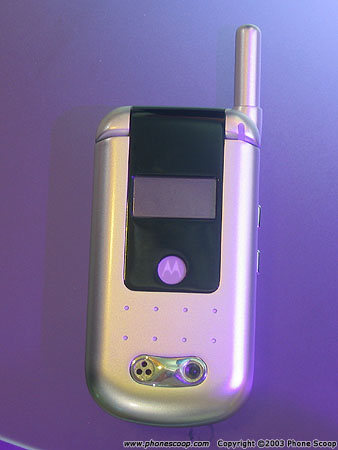
The outside of the V810. A small mirror for self-portraits is cleverly integrated into a chrome accent surrounding the camera lens and flash. Despite looking like a speaker grille, the three holes next to the camera are supposedly the flash.
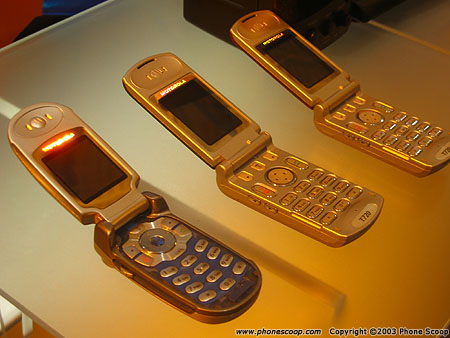
The E310 next to two T720s. The E310 has a translucent keypad and side panels, with flashing lights underneath that sync with ringtones and games.
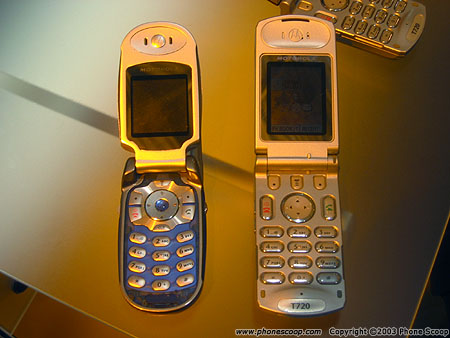
Another view of the E310 next to a T720.
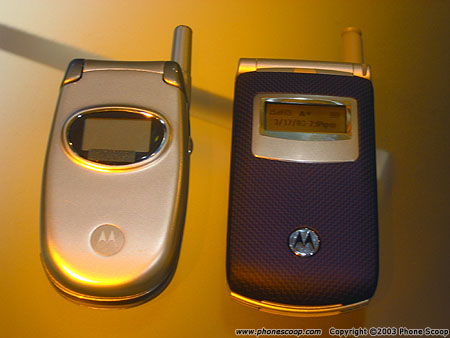
The E310 closed, again next to a T720.
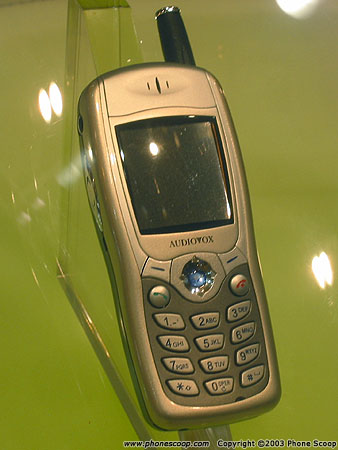
Audiovox's new 8400 series. The 8400 will have BREW, while the 8450 will have Java. They pack in a fair amount of features, but are designed to address a low- to mid-range market. These should be available in the 3rd quarter.
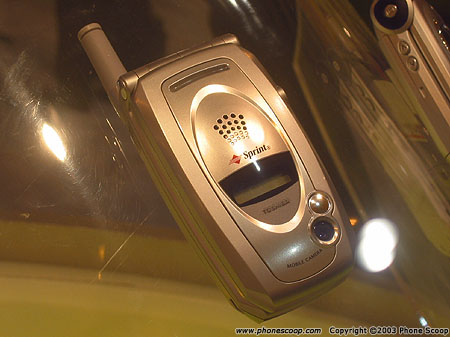
The 9600 camera phone has unfortunately been cancelled.
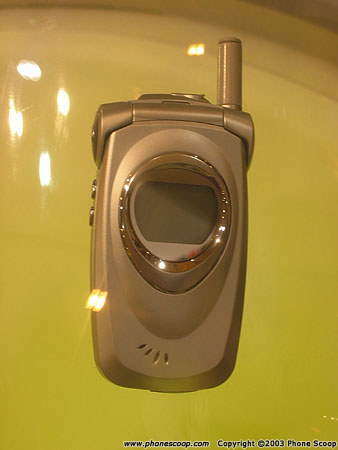
The 8900 is smaller than the 9600, and will fill a need for a small, affordable camera phone. It is planned to be available in the August/September timeframe.
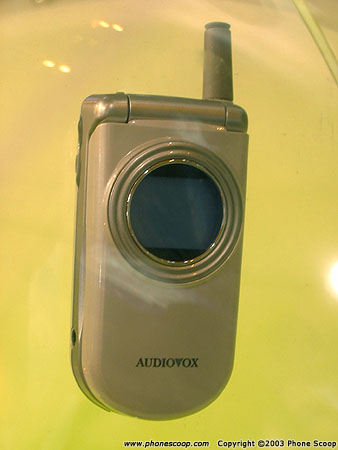
The 8600, which should be the smallest CDMA 1x color clamshell in the U.S. when it is released in the second quarter. It's really, really tiny.
Page 3
The really big news from Audiovox is that they are expanding into GSM phones. A series of three GSM camera phones made by Sharp were detailed, although only the first model - the GS-200 - was on display. I covered the GS-200 a while back - it's very similar to the GX-10 in the UK.
The next model is the GS-300, which will have a 240 x 320 pixel main display, color external display, Java, 350K pixel camera, and video capture. The GS-400 has the same specs, but adds quad-band GSM, a megapixel camera, SD card expansion slot, and 40-chord polyphonic ringtones.

The new Siemens lineup, in order from high-end to low-end: SX1, SL56, S56, M56, C56, CT56, and A56. Interesting factoid: you might notice some parallels with the model naming of a certain brand of luxury cars...
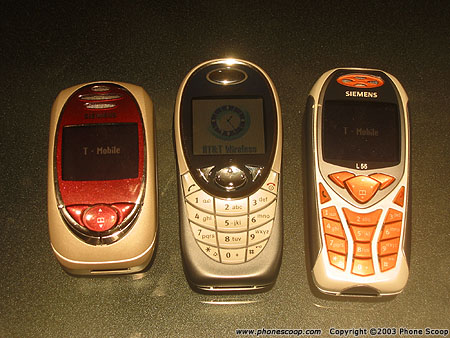
The SL56 (left) and M56 (right) are the American versions of the SL55 and M55 announced last week at CeBIT.
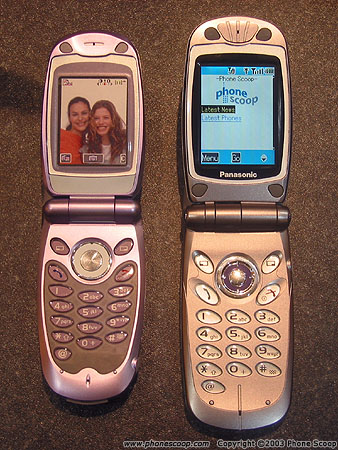
The new Panasonic X70 next to the GU87 that was just released by AT&T Wireless. A version of X70 is also slated for the U.S. in Q4. The X70 is about 20% smaller than the GU87.
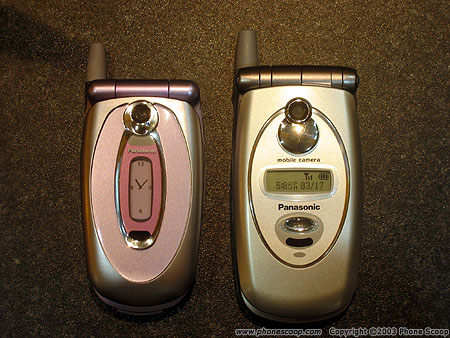
A closed view of the same two phones. The G50 and G60 (announced with the X70 at CeBIT) are not planned to be released in the U.S.
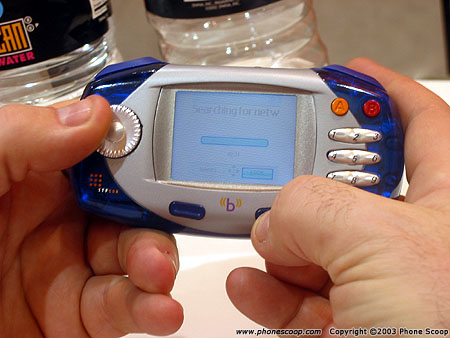
The Bingo wireless gaming device reference design from TTPCom. The navigation control has 8-way action, and also turns as a jog dial. This is one of only two working units in the world (the other was at CeBIT). As a reference design, it's more of a concept than a final product, although it does work, and the games look good. No major manufacturers or carriers have signed on to offer the device yet, although discussions are underway.

The Bingo has gaming keys on the top like many video game controllers, and supports multiple simultaneous key presses, so you can, for example, turn left while also braking in a racing game. Bingo games are developed in C++, and can be ported from platforms such as Game Boy Advance in as little as two days.
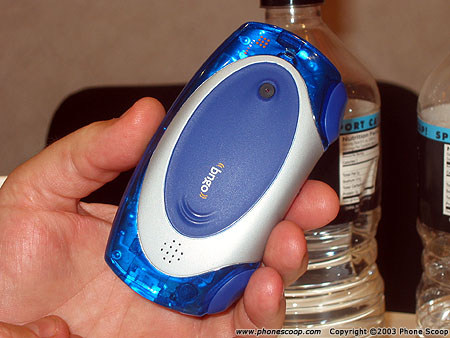
A camera is integrated in the back, as well as the speaker and microphone for using the device as a phone.

The device has a good shape and feel. The final version will require fewer internal components, and thus be thinner. The gaming engine that powers the Bingo has already been deployed for embedded games in some phones in Asia, and has been receiving good reviews.
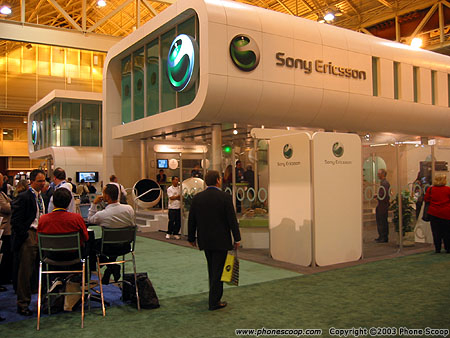
The retro-cool Sony Ericsson booth, which is actually in the shape of a giant "se"
Page 4
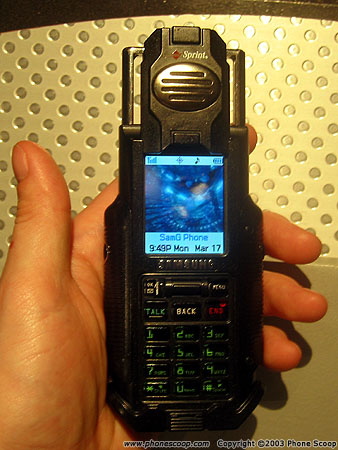
The Samsung/Sprint Matrix Phone. Features are as described on this site earlier. The left side button triggers a spring release for the sliding part. What looks like a button on the right side is actually just plastic molding for symmetry. The display and interface are very similar to Samsung's SPH-A500. However, the Matrix phone has far fewer features, and of course an animated Matrix theme pervades the interface.
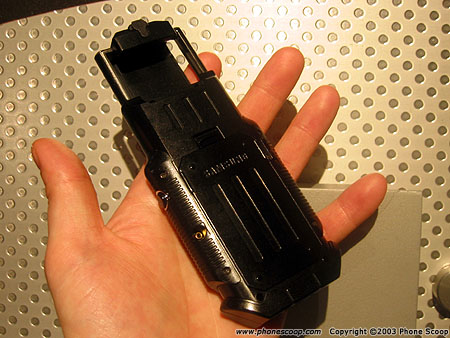
The back of the Matrix Phone. A headset jack is located behind the earpiece on the sliding part.
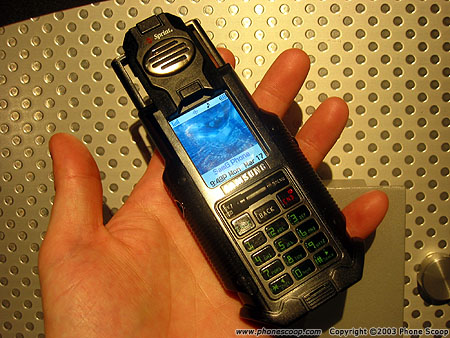
Another view. According to the press release, the phone itself will be "prominently featured throughout the movie."
Day 2
Page 1
lg booth
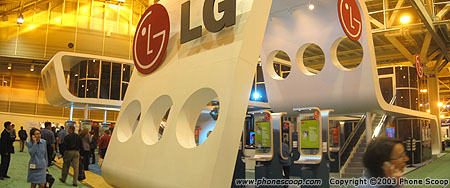
The really retro-cool LG booth. Comparisons with the Sony Ericsson booth were inevitable. Most people I talked to agreed that these two booths were the most impressive. The Siemens "castle" was also pretty interesting. There will be an aerial view of the Siemens booth in the Day 3 report.
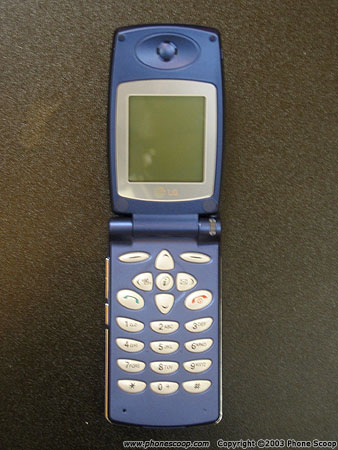
In the handset area, one of the biggest announcements was LG's introduction of its first GSM phones for North America. Here is an inside view of the LG 4010.

A side view of the 4010. The 4010 fairly small overall, but notable mostly for its incredible thickness - or rather its lack thereof.
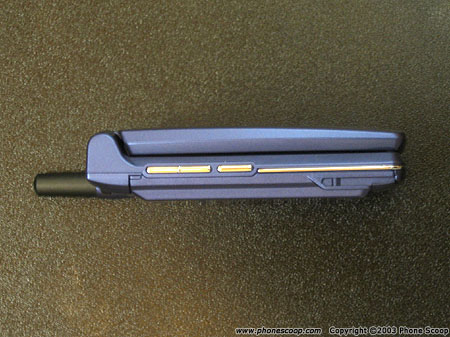
The 4010 fills the need for a small, affordable, folder-style GSM phone for North America. Almost all of the current low-end GSM phones are block-style models. The folder-style models are mostly mid- or high-priced models from Motorola and Samsung. So the 4010 fills an important hole in carriers' lineups, and the ultra-slim form factor is a nice bonus.
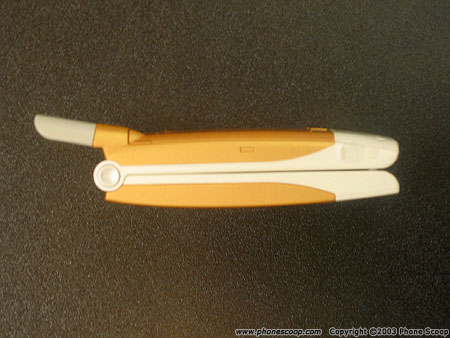
A side view of the new color-display 4050. More photos of this and the other new LG phones can be found in my CTIA LG Gallery. The dark colors shown in the gallery will be the final colors, not orange as shown here. The unique curved edges at the bottom of the phone make it easy to open. Both this phone and the new VX-6000 use the same OLED outer display; the main part of the display is monochrome blue. In addition, there are six multi-color dots at the top that can flash in various patterns. The display is extremely bright and easy to read.
Last year, LG was just starting to establish itself as a new brand for phones in the U.S. This year, they are expanding into GSM. They seem to have some serious momentum going, so I asked "what's next?" The answer: 1xEV-DO. LG is a leader in 1xEV-DO phones in Korea, and they plan to bring that expertise to the U.S. sooner rather than later. For those who don't know, 1xEV-DO is the next step for 3G CDMA after 1xRTT, and it offers very high data speeds - averaging around home DSL speeds! It's plenty fast for full-motion video services. Combine this with the news this week that Verizon is pushing forward with its 1xEV-DO deployment, and I'd say we have a lot to look forward to!
Other news from LG is that their much-delayed VX-9000 smartphone has just been approved by Verizon, and will be available from indirect retailers in the next few weeks. It no longer features Bluetooth, unfortunately. There aren't any additional smartphones on LG's immediate roadmap, but if they do continue in that area, they will go with a standard OS such as Palm or Pocket PC. The VX-9000 and earlier smartphones from LG have used the relatively unknown REX operating system, a choice which has been harshly criticized.
Another area in which LG has been critcized in the past is the user-friendliness and appearance of it user interfaces. LG told me they have been making a big effort to improve in that area, and I'm happy to report that the new phones - I tried the VX-6000 briefly - seem to be a major improvement. It's good to see LG listening to feedback on these important issues and taking action.
Finally, LG will be moving forward on other technology fronts in 2004, including EDGE and GAIT. I was suprised to hear GAIT mentioned, but they confirmed that a GAIT phone is likely (although not finalized) for 2004. I asked Nokia, Sony Ericsson, and Siemens about GAIT, and they all indicated that they weren't seeing strong demand from carriers for additional GAIT models.
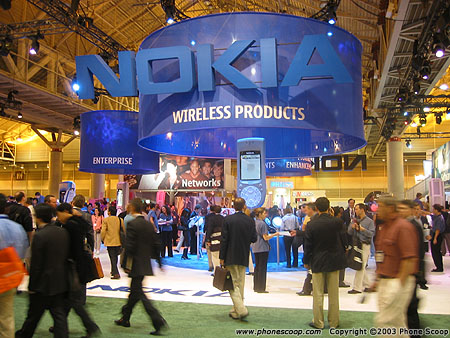
The Nokia booth. One very major announcement that I somehow missed until the third day is the new Nokia 3600 - a GSM 850/1900 version of the 3650 Series 60 camera phone. This is big news - I believe it is the first Series 60 phone designed specifically for North America. It looks identical to the 3650, so that is a jumbo model of it standing in the middle of the booth.
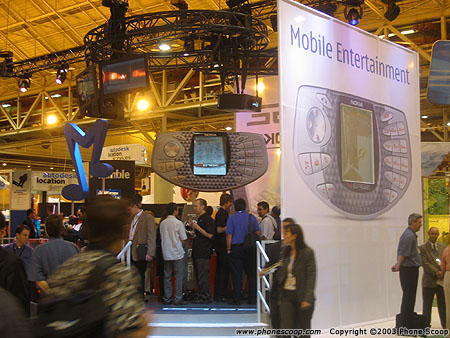
Of course, the N-Gage section of Nokia's booth was a big hit. I played with it a bit - it's really slick. The big advange over the TTPCom Bingo is of course the large development community Nokia has been able to create. That's what makes or breaks a software platform like this.
The N-Gage is fairly flexible in the range of games it can play. At the basic end, it can play Java games, although the performance won't be great. Moving up, it can also play games designed specifically for Series 60 devices. Performance should be a bit better with these. Moving further up, games designed specifically for the N-Gage can take advantage of special hardware acceleration, and of course performance will be best with these games. The serious games will be sold on read-only MMC cards, allowing an unprecedented amount of memory for graphics and high-quality stereo sound.
The N-Gage can be held up to the ear and used as a phone, although the speaker and mic are located along the top edge, so it looks kind of funny when you hold it up at a right angle to your head. Presumably most people will want to use a headset with it.
Look for more on Nokia in my Day 3 report...

A number of new Korean and Japanese phones were showcased in the Qualcomm booth. This appears to be the Korean phone on which the new Kyocera Slider phone is based.
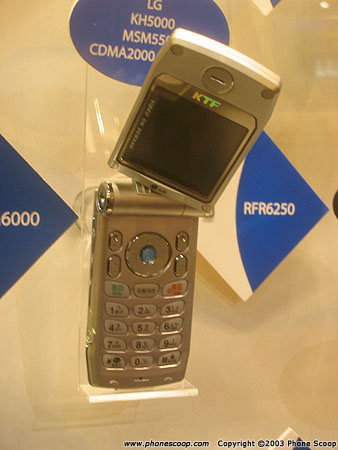
This is a Korean LG 1xEV-DO phone that was demonstrated briefly in the opening keynote. The camera is located in the hinge and faces sideways. The display is therefore designed to stay in position twisted sideways - like a camcorder - for use as a viewfinder. The new Panasonic 3G phone for DoCoMo in Japan also has this design.
Page 2
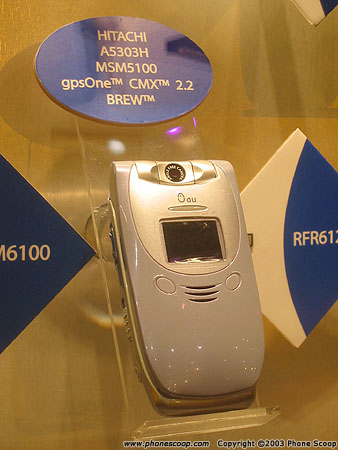
A stylish Hitachi CDMA phone for Japan. I didn't see a Hitachi presence at the show, but they are making a big push into the U.S. market through their relationship with Sprint PCS. Hopefully they will soon offer a phone like this here.
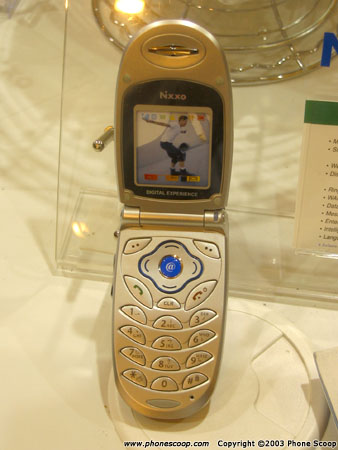
One relatively unknown company that is contemplating entering the U.S. market is Nixxo. Shown here is the NXG 9230, a GSM 850/1900 phone with class 10 GPRS, a 4096-color STN display, and 40-chord polyphonic ringtones.
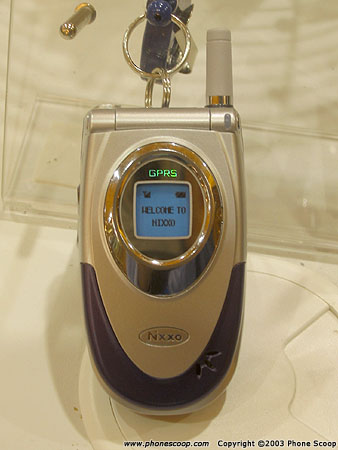
A closed view of the Nixxo NXG 9230.
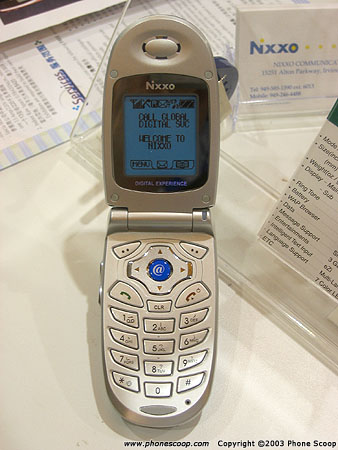
This is the Nixxo NXG 9150. It is similar to the 9230, but steps down to a monochrome display and 16-chord ringtones.
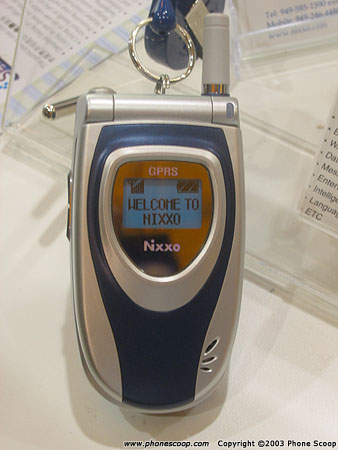
A closed view of the Nixxo NXG 9150.
It wasn't on display, but Nixxo also has a quad-band GSM phone planned for early 2004. The NXG 9250 will have a 65,000-color TFT main display, a 4096-color outer display, a swivel camera, class 10 GPRS, MMS, and 64-chord polyphonic ringtones. The fact that it also specifically includes E-911 support is a sign that it is planned specifically for the U.S. market.
Another relatively unknown company planning to enter the U.S. market is Telson. Unlike Nixxo, they have very serious ongoing talks with a major carrier - Verizon Wireless. It's not final, but apparently Verizon is currently planning to offer two of their upcoming models in the second half of the year. They looked pretty neat, with a typical folder-type dual-display design. At least one had a color main display. Unfortunately, they did not allow pictures in the booth, and somehow I misplaced the brochure I picked up with pictures and specs. (grrrr...)
However, I did take notes on their 8300 model, which is slated for the U.S. in February 2004. It features a slick-looking folder design, with dual color displays and a swivel camera. The main display is 260,000-color TFT, while the outer display is 4096-color STN. It's a tri-mode, and it features BREW, video capture, MMS, a "3D GUI", voice dialing, and 48-chord polyphonic ringtones.
This might be good time to mention - for anyone who doesn't follow the industry - that phone release dates and feature lists change frequently. This happens in response to feedback from user testing, and results from carrier testing. Delays are pretty much the norm in this industry. So whenever you see a date for a phone - even when it's 'official info' from the manufacturer - take it with a huge grain of salt.
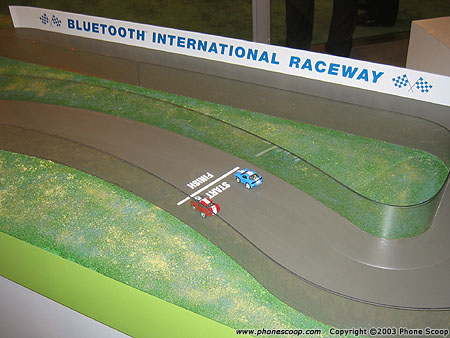
Sony Ericsson had a really neat Bluetooth demo set up in their booth. Their engineers managed to cram a Bluetooth module into a couple of those tiny micro-RC cars!
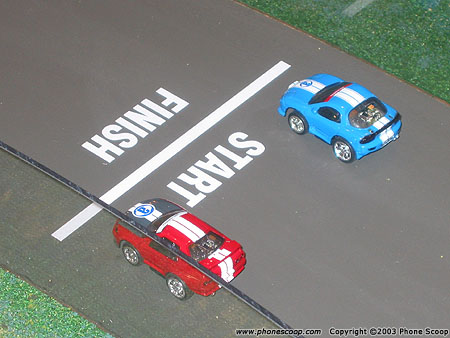
A closeup of the Bluetooth micro-cars.

Hey - that's me! ...using a T68i to control the little red car via Bluetooth. As you can see, I'm not a very good driver, but I don't care - I want one!
Page 3
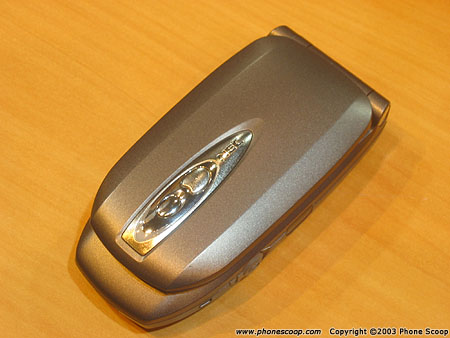
The NEC 515. This highly-anticipated phone was introduced at last year's show, and still hasn't been released. It's an ambitious phone, though - and NEC's first phone for the U.S. since the analog days - so the delay is somewhat understandable. It is now planned for release in the second quarter, and the NEC reps seemed confident about that timeframe. Since it was first unveiled, one of the things that has changed is the color - this darker shade is the final shipping color, as opposed to the orginal silver.

The NEC 515 next to a Samsung SPH-A500. The 515 has a huge, brilliant 65,000-color TFT display. It's one of the reasons NEC calls this a "High Definition Mobile" phone, and I would say it's justified. (The term "high definition" here has nothing to do with HDTV, by the way.)
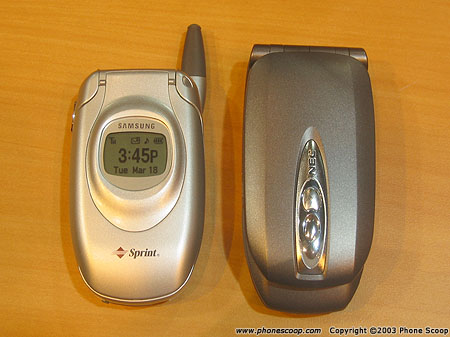
Another comparison with the A500. The 515 has all the features you'd expect in a high-end GSM/GPRS phone, plus a few firsts. One of them is quad-band roaming. The 515 should be one of - if not the - first quad-band phone on the market. The second major first is dual processors - the 515 has a main processor as well as a dedicated processor just for Java. Combined with its great display, this makes the 515 pretty much the ultimate Java phone - both for games and business applications. To that end, NEC has already announced partnerships with Dwango Wireless and Vuico, for Java games and Java enterprise applications, respectively, for the 515.
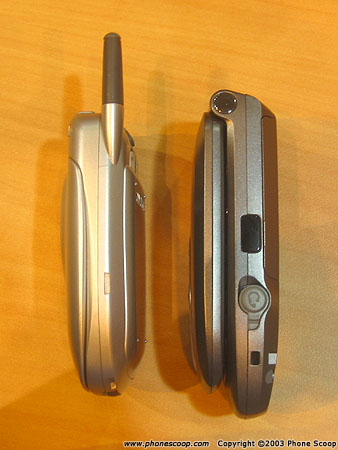
The 515 is not the smallest phone out there, but it's not bad at all for a phone with an internal antenna and such a large display.
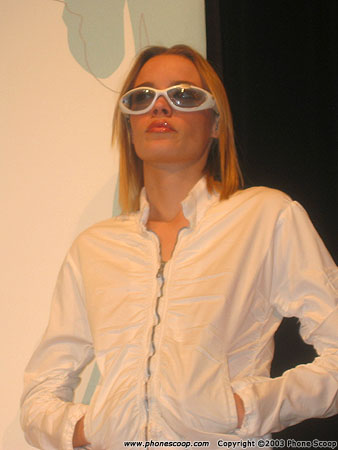
The Frog Design / Motorola wearables concept was the grand finale for the "Fashion in Motion" Wireless Fashion Show. I published a detailed report on the concept when it was first announced last week. Shown here are the goggles, which feature a heads-up display, and an integrated video camera & earphones.

Models showing the WDA smartphone and the "wristable", which packs all the functionality of the WDA into a watch form factor. For reasons that are probably obvious, I felt compelled to come back the next day for another show... so look for more pics from the fashion show in my Day 3 report.
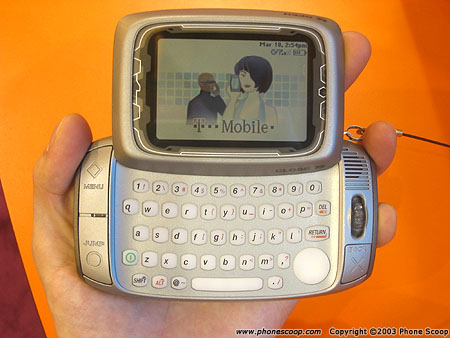
Danger made the semi-official announcement at the show that they will be coming out with a color Hiptop, and T-Mobile will be carrying it this summer. They tested a number of different types of displays, but said they have settled on the 65,000-color TFT LCD shown here. This particular shot is with the backlight off, so it appears to be a very good transflective display.

Here is the color Hiptop with the display closed and the backlight on. As you can see, the display looks great.

Here is another shot of the screen, displaying part of the Phone Scoop front page. The browser re-formats full web pages for the small screen, breaking up tables so that no horizontal scrolling is required. This is one of the hot new trends - all of the major players are touting this feature now - and the Danger browser does a decent job of it.
When it is first released, the color Hiptop will have nearly identical features to the current model (other than the display, obviously). But a major software upgrade is slated to be available soon after, which will add several new features the platform, according to Danger.
Day 3
Page 1
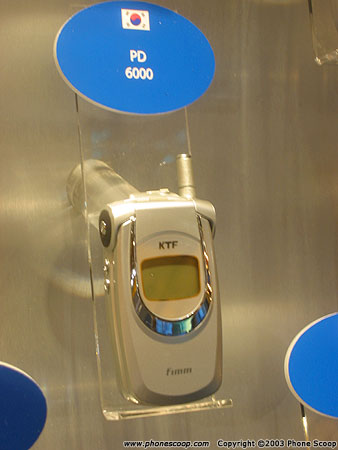
Here are a few more international phones that were on display at the Qualcomm booth. This is the Korean phone on which the new Audiovox 8900 is apparently based.
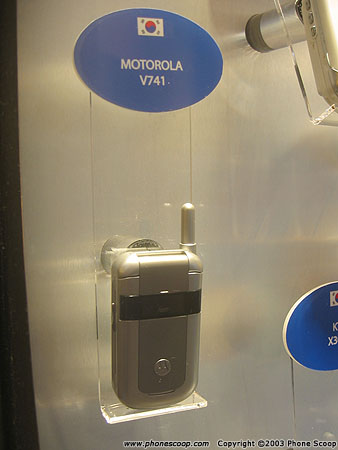
The Motorola V741, which appears to be the rough basis for the new Motorola V810.

A nifty Korean LG phone. A trend is starting to emerge for phones with mirrored faces or displays. This is certainly one example. No U.S. counterpart just yet.
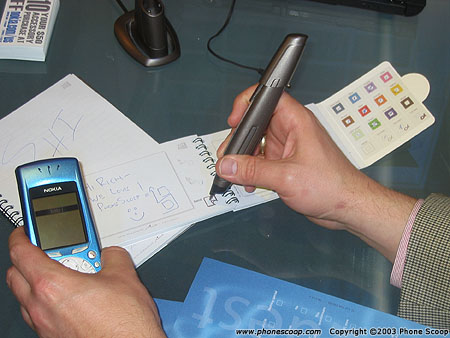
The Nokia Digital Pen with Bluetooth. It uses Anoto technology, so special paper is required. Nokia offers two types of pads with the special paper: a large notepad and a smaller MMS pad. The pads include a flap with special boxes you can tap to change the line color and thickness.
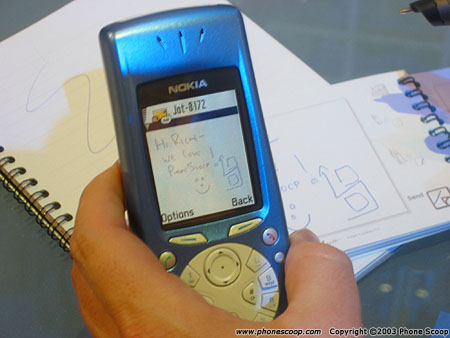
A Nokia 3650 displaying a sketch sent from the Digital Pen via Bluetooth. The sketch can be saved or sent via MMS. Nokia's announcement of the 3600, (a GSM 850/1900 version of the 3650,) should mean much wider distribution of this versatile phone here in the U.S.

The new Nokia 6585 next to a 7210. The 6585 is Nokia's first small, color-display CDMA phone, and possibly the first CDMA phone for North America with a built-in FM radio.

The 6585 is slightly thicker than the 7210, but does add a 2.5mm headset jack. Don't let the photo deceive you, though - the 7210 is a really thin phone, so the 6585 is still a very nice size.
One of the booth reps also let slip that Nokia is planning a CDMA camera phone similar to 6585 for Q1 2004. I assume this would be a similar form factor to the recently-announced 6220 EDGE phone for Europe.
I was able to ask Nokia spokesperson Keith Nowak about Nokia's future directions, and see a live demo of Nokia's PTT (push-to-talk) solution.
One thing I hear a lot is "why doesn't Nokia make a folder-style phone?". So I asked... and I was told that folder-style phones still aren't on the horizon, but "look for some new, innovative form factors [from Nokia] in a few months." Interesting!
The Push-To-Talk hype was definitely at a fever pitch at this show. It was the phrase on the tip of everyone's tongue. The Nokia Push-To-Talk demo was interesting, although not the most impressive PTT demo at the show. The demo featured two modified 6200s. Even though the 6200 is an EDGE phone, the demo used GPRS. Nokia's PTT solution works fine over GPRS, which is good. It had about a 2-second latency, which isn't bad, considering it was supposedly relaying through a server in Finland. Sound quality was hard to judge due to the high ambient noise from the show floor.
Although it works over GPRS, Nokia's PTT solution will not run on existing hardware - it will require special new phones, which Nokia plans to have available in the first half of 2004.

More from the "Fashion In Motion" wireless fashion show. Here are models showing off the LG 6000 and 5350.
Page 2
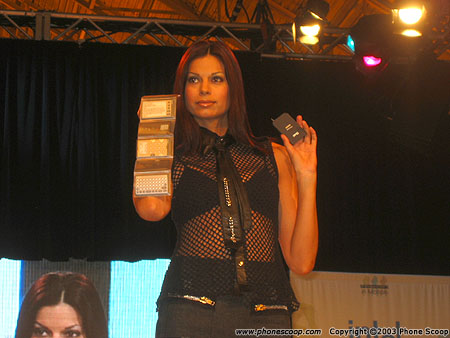
"Alvissâ„¢": a set of concept devices by Sanyo. Each is the size of a credit card and serves a different function. They all communicate via Bluetooth and "PMG" software from IXI Mobile.
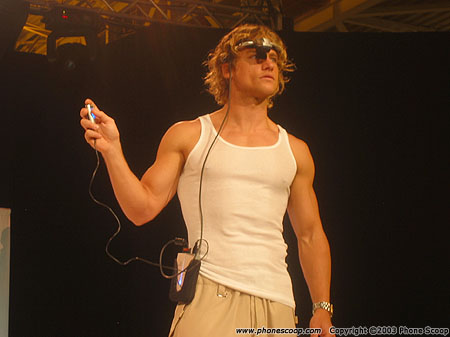
A wearable computer concept with a heads-up display. Didn't catch the company, but it looks kind of cool. (And I didn't want the ladies to feel left out.)
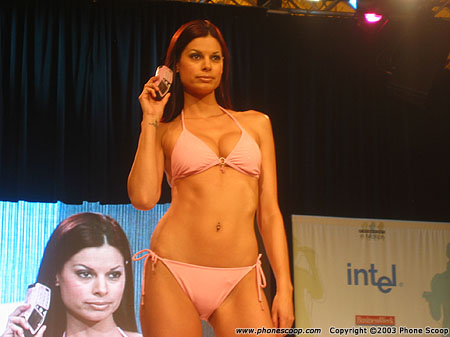
The Wildseed (Kyocera Kurv) phone.
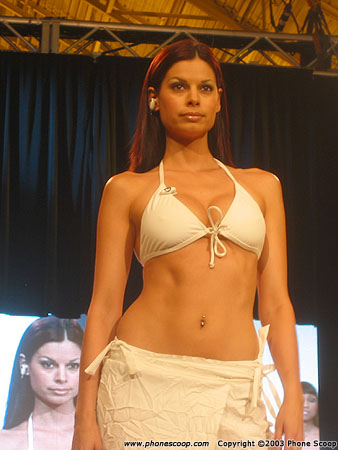
The Motorola Bluetooth headset and Push-To-Talk button from the Frog Design wearables concept.

A close-up of the Motorola / Frog Design wearables concept.
By the time I met with Kyocera, I was running a bit short on time, so I don't have any photos from the meeting, but there are a few from MobileFocus in the Preview report. Most of Kyocera's lineup is pretty straightforward, but there are a few tidbits I learned that are worth passing on.
First, the highly-anticipated 7135 has finally been approved by Verizon, and should be available from Verizon's business channels and the Kyocera web site the week after the show, and through Verizon's consumer channels a couple weeks later. Also, Kyocera has been working with Veo to get their SDIO camera working on the 7135.
The Wildseed phone - AKA the Kyocera Kurv - is definitely a promising product, but I was disappointed by its size. It's a bit large, and especially thick. If they could shave a third off the thickness, I think it would be great. But at its current size, I think it's only a matter of time before people start calling it a "brick" phone. Some good news is that - in response to focus-group feedback - Kyocera has decided to add a camera, BREW, FM radio, MP3 playback, and MMS-like functionality to the design. But the bad news is that these changes will push the release back to the 4th quarter, and they don't expect to reduce the size in that time. I have to wonder if they're just trying to pack too much into this thing, at the expense of actually shipping something.
The SE47 "Slider" is probably the most unexpected and interesting product in the Kyocera's new lineup. MVNO Virgin Mobile will be offering it, and it is currently being considered for the honor of being the first official "MTV Phone". It's definitely a distinctive design, and it has a good mix of features to back it up.
One thing that's been bothering me recently is that Kyocera doesn't seem to transfer much of its handset expertise from Japan to the U.S. Kyocera's Japanese handsets blow away anything they've announced here - by a wide margin. Competitors such as Sharp and Sanyo are set to trounce Kyocera if they don't act quickly. Also, I was disappointed that the Kurv was the only camera phone in Kyocera's lineup.
So I asked the hard questions: "Why doesn't Kyocera seem to be very good at technology transfer from its own divisions in Japan? And why no camera phones?" The answer to both questions was simple. They definitely feel the heat from companies like Sanyo, and they are working aggressively to improve internal cooperation, to bring more technology from their Asian divisions to the U.S. market. The Slider marks the start of that increased technology transfer. It will culminate in Q1 next year with an industry-leading entry into the U.S. camera-phone market. I can't share everything I was told, but I can tell you I'm pretty excited by what I heard. Kyocera may be falling behind at the moment, but a big rebound seems to be right around the corner.
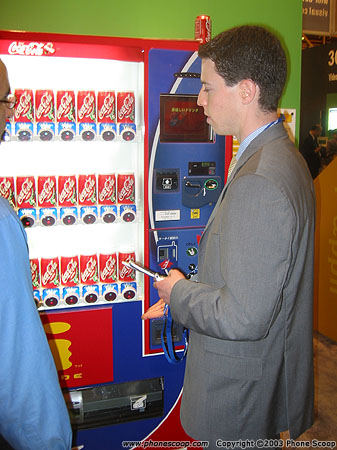
The "cMode" Coke machine at the DoCoMo booth. DoCoMo had a semi-large booth showing all the cool stuff they have in Japan. It's all very cool stuff, but Japan has mostly been eclipsed by Korea in mobile technology these days, and as I mentioned, companies like Sanyo are bringing Japanese technology to the U.S. faster then ever before. So DoCoMo's latest isn't nearly as far-out and impressive as it used to be.
As I mentioned in the Nokia bit earlier, Push-To-Talk (PTT), was definitely one of the major buzzwords for the show. One pioneer in this field is Mobile Tornado. Recently they partnered with Comverse. Mobile Tornado brings their PTT software to the table, while Comverse provides the back-end hardware and sales force.
Like most of the hottest new PTT technologies, Mobile Tornado's system is interoperable among several types of systems, including CDMA 1xRTT, GPRS, and Wi-Fi (802.11b). Unlike other systems, (as far as I can tell,) Mobile Tornado's system even interoperates with iDEN, which is pretty cool. For example, a CDMA carrier using Mobile Tornado's solution could theoretically link up with Nextel's system and let customers use PTT between the two networks.
Of course he was just a wee bit biased, but the Mobile Tornado rep was quick to point out the flaws in competing systems. According to him, other systems guzzle battery life, can't support more than a few thousand users, and completely tie up the phone during a PTT session. Mobile Tornado's system, meanwhile, can support up to two million users, is frugal with battery life, and supports full PTT call-waiting. I didn't have time to run those claims by the other companies, though, so take that all with a grain of salt. Mobile Tornado's system can support such a large number of users because it can handle local one-to-one sessions in a peer-to-peer fashion. Only long-distance and one-to-many sessions require the involvement of a server, and those usually make up only five percent of all PTT calls.
Like Nokia's system, Mobile Tornado's phone software must be embedded in the phone. It can't be added to existing phones via Java or BREW. They do, however, have client software for PDAs, which they were demonstrating the system on a couple of iPAQs over Wi-Fi.
The phone demo used two modified Samsung SPH-N400s running on the Sprint PCS network. (Hmmm...) It was pretty quick, with latency around one second. Not as fast as iDEN (Nextel), but pretty darn good compared to the rest of the competition. I was impressed.
While quick to dismiss most competing systems, the Mobile Tornado rep had nothing but good things to say about QChat, Qualcomm's PTT solution for CDMA. Apparently QChat would have blown everything else out of the water - if Nextel hadn't snatched up an exclusive U.S. license to the technology. Clearly, it was a smart move for Nextel, but it is a bit frustrating that the best PTT technology for CDMA may never be deployed in the U.S. (Unless Nextel switches to CDMA, or Verizon or Sprint buys Nextel.)
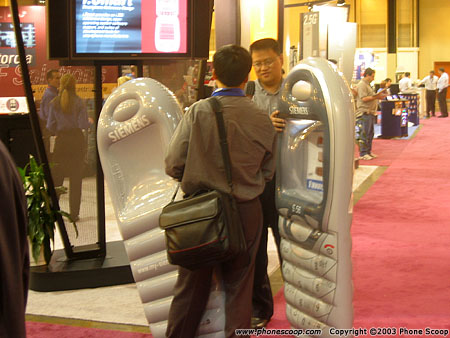
Siemens was giving away inflatable pool floats in the shape of a giant S56. They were only giving them away inflated, so plenty of people were walking around with huge inflated S56s. I thought it was a pretty clever promotional stunt.
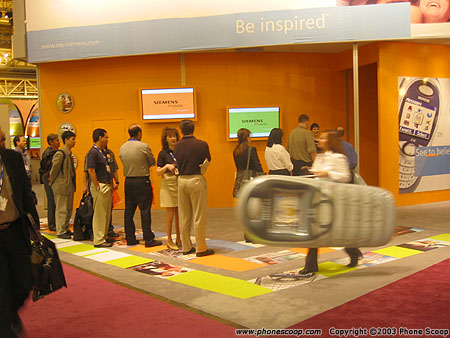
This is the line of people waiting to get their super-size S56. Throughout the show, their was a halo of people around the Siemens booth desperately trying to deflate them. Thankfully, as a member of the press, I was able to get one uninflated. :-)
Page 3

The opposite corner of the Siemens booth, as seen from above. It was hard to get a picture that really gave a feel for the booth, since it was mostly enclosed. The front entrance (under the logo) was an Omnimax-like surround-video room. It was pretty wild.

Bill Gates giving the keynote for the first annual Microsoft Mobility Developer's Conference. The MMDC was located in the same convention center, and started right as CTIA was ending, so this served as a kind of closing keynote for CTIA. Bill showed the hilarious video poking fun at Microsoft that's been in all his recent keynotes.
The first major announcement was the availability of the .NET Compact Framework, which will make it easier for developers to write Internet-enabled software for Pocket PCs (and soon Smartphones). Also, .NET CF was demonstrated running on a Smartphone for the first time. The second major announcement was the availability of a Smartphone Developer's Kit, which includes the Compal AR-11 Smartphone from Red-E.
So that was the show! It was thoroughly exhausting, but well worth it. Hopefully you enjoyed the coverage. Check back toward the end of the week for my wrap-up article, which will summarize all these random thoughts in a little more cohesive manner, and add some analysis and perspective.


 iPhone 14 Plus Offers a Big Screen For Less
iPhone 14 Plus Offers a Big Screen For Less
 Samsung S24 Series Adds More AI, Updates the Hardware
Samsung S24 Series Adds More AI, Updates the Hardware
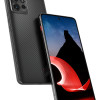 Lenovo ThinkPhone by Motorola Caters to Businesses
Lenovo ThinkPhone by Motorola Caters to Businesses
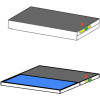 Foldable Google Pixel Confirmed by FCC
Foldable Google Pixel Confirmed by FCC

